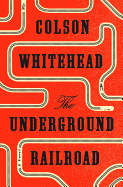
The Underground Railroad tells the story of Cora, an outcast even among her fellow slaves--the legacy of her fugitive mother and a fierce confrontation over a garden plot lend her an unbalanced reputation--who makes a break for freedom early in the novel. Fleeing the horrors of the plantation and an almost demonically persistent slavecatcher by the name of Ridgeway, Cora is aided on multiple occasions by the Underground Railroad.
Instead of the metaphorical organization from history, Whitehead's Underground Railroad is an immense network of actual underground railways taking fugitive slaves from station to station. Whitehead writes: "Two steel rails ran the visible length of the tunnel, pinned by wooden cross-ties into the dirt. The steel ran south and north presumably, springing from some inconceivable source and shooting toward a miraculous terminus." When asked who built the railroad, a station agent simply responds, "Who builds anything in this country?" Whitehead isn't interested in the how and why so much as the concept of hopes, dreams, fears and simple imagination made manifest--it's not quite magical realism, but there are points of similarity.
This audacious fudging of history continues throughout the book and gets increasingly phantasmagorical as the story progresses. Cora's path is haphazard, strange, wandering from one temporary patch of safety to another. The wildest, most thrillingly implausible part of The Underground Railroad is not the many-miles-long underground tunnels, but the persistence of hope in the face of senseless, persistent horror. --Hank Stephenson, bookseller, Flyleaf Books

